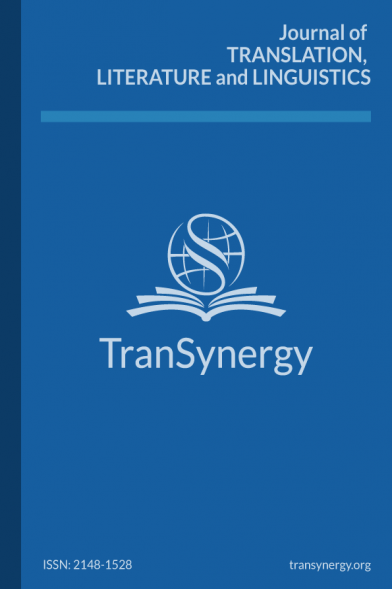The Seventh Function of Language A Novel: The Linguistic Turn in Fiction
This study aims to discuss The Seventh Function of Language: A Novel (2017) by Laurent Binet as a novel in which the semiology, the science of signs, is introduced into the fiction, in addition to the linguistic issues. Taking its source of inspiration from The Name of the Rose by Italian semiologist and novelist Umberto Eco, the story of a manuscript for which people are killed, semiology is emplaced into the narrative form. Again, reinterpreting and reproducing this trope of the search for a lost manuscript and installing it at the heart of the 80’s intellectual arena, the novel has a conspiratorial tendency throughout its plot: the story begins with the (real-life) death of Roland Barthes in 1980. “The greatest critic”, a world star of semiology, died after being hit by a laundry van after leaving lunch with François Mitterrand, who was running for the presidency at the time. Passing through reality to build the fiction, the novel parodies conspiratorial tendencies and traces the question: What if the famous semiologist was killed because he would have discovered, like a mad scientist, a seventh function of language in addition to the first six, previously highlighted by the linguist Roman Jakobson: the absolute power to persuade. It is simply the enunciatory power of shaping history. In search for this magical power of control over the addressee, the novel takes us back to the last great era of French intellectuals such as Roland Barthes, Umberto Eco, Michel Foucault, Jacques Derrida Gilles Deleuze, Judith Butler, Philippe Sollers, Julia Kristeva by adding novelistic features to these figures. This was the time of “linguistic turn” when the conviction that philosophical questions were necessarily entangled with the limits of language dominated the humanities. With a line-up of characters plucked from the heavyweights of 20th-century French linguistic and critical theory, and a postmodern mashup of texts, facts, and falsities, Binet introduces the semiology into the narrative form. The present study explores to what extent fiction can encompass theoretical knowledge and construct its building blocks.
The Seventh Function of Language A Novel: The Linguistic Turn in Fiction
This study aims to discuss The Seventh Function of Language: A Novel (2017) by Laurent Binet as a novel in which the semiology, the science of signs, is introduced into the fiction, in addition to the linguistic issues. Taking its source of inspiration from The Name of the Rose by Italian semiologist and novelist Umberto Eco, the story of a manuscript for which people are killed, semiology is emplaced into the narrative form. Again, reinterpreting and reproducing this trope of the search for a lost manuscript and installing it at the heart of the 80’s intellectual arena, the novel has a conspiratorial tendency throughout its plot: the story begins with the (real-life) death of Roland Barthes in 1980. “The greatest critic”, a world star of semiology, died after being hit by a laundry van after leaving lunch with François Mitterrand, who was running for the presidency at the time. Passing through reality to build the fiction, the novel parodies conspiratorial tendencies and traces the question: What if the famous semiologist was killed because he would have discovered, like a mad scientist, a seventh function of language in addition to the first six, previously highlighted by the linguist Roman Jakobson: the absolute power to persuade. It is simply the enunciatory power of shaping history. In search for this magical power of control over the addressee, the novel takes us back to the last great era of French intellectuals such as Roland Barthes, Umberto Eco, Michel Foucault, Jacques Derrida Gilles Deleuze, Judith Butler, Philippe Sollers, Julia Kristeva by adding novelistic features to these figures. This was the time of “linguistic turn” when the conviction that philosophical questions were necessarily entangled with the limits of language dominated the humanities. With a line-up of characters plucked from the heavyweights of 20th-century French linguistic and critical theory, and a postmodern mashup of texts, facts, and falsities, Binet introduces the semiology into the narrative form. The present study explores to what extent fiction can encompass theoretical knowledge and construct its building blocks.
___
Barthes, R. (1967). The Death of the Author .
Barthes, R. (1975). Roland Barthes . Editions du Seuil.
Barthes, R. (2021). Bir Deneme ve Bir Ders: Eiffel Kulesi ve Açılış Dersi. Yapı Kredi Yayınları.
Binet, L. (2015). La Septième Fonction du Langage. Grasset.
Binet, L. (2017). The Seventh Function of Language: A Novel. (S. Taylor, Çev.). Farrar, Straus and Giroux.
Birns, N. (2017). “The Three Phases of the Linguistic Turn and Their Literary Manifestations”. Partial Answers 15, no. 2(2), 291–313,.
Books, V. (2023, June 19). www.youtube.com. Vintage Books: https://www.youtube.com/watch?v=wqT3mBwYk5g adresinden alındı
Dervişcemaloğlu, B. (2014). Anlatıbilime Giriş. Dergah yayınları.
Eco, U. (2008). The Name of the Rose . Vintage Books.
libraire, l. g. (2023, June 19). www.youtube.com. La grande libraire: https://www.youtube.com/watch?v=hwRJPg7XhyQ&t=4s adresinden alındı
Middleton, R. (1990/2002). Studying Popular Music . Open University Press.
Palahniuk, C. (1997). The Fight Club. Vintage.
Porter, S. E. (2021). What is a text? Linguistic turn and its implications for New Testament Studies. G. R. Lanier, & J. N. Reid (Dü) içinde, Studies on the Intersection of Text, Paratext, and Reception. Brill.
www.universalis.fr. (2023, June 19). Encyclopædia Universalis: retrieved from https://www.universalis.fr/encyclopedie/linguistic-turn-histoire/
